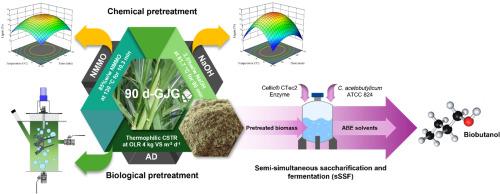化学和生物预处理对半同步糖化发酵产丁醇的影响
IF 3.8
Q2 BIOTECHNOLOGY & APPLIED MICROBIOLOGY
引用次数: 0
摘要
将生物质转化为生物燃料是可持续能源生产的关键战略。木质纤维素生物质的有效预处理是提高其生物转化效率的关键。采用氢氧化钠(NaOH)和n -甲基morpholine N-oxide (NMMO)对化工巨草(GJG)进行预处理,系统确定了预处理的最佳时间和温度。在合适的预处理条件下,naoh预处理的GJG(81.7℃,60.0 min)比NMMO预处理的(138.3℃,10.3 min)保留了更高的纤维素含量,而厌氧消化(AD)预处理的GJG性能略有变化。在半同步糖化发酵(sSSF)过程中,naoh预处理的GJG在前24 h内葡萄糖浓度最高,为48.3 g L−1,在乙酰丁基Clostridium acetobutylicum ATCC 824发酵96 h后,丁醇浓度最高,为8.95 g L−1。两种化学预处理均能产生令人满意的丙酮-丁醇-乙醇(ABE)产率,AD预处理的GJG产率较差。提出了一种适宜的丁醇转化顺序,其次是甲烷,因为该产品具有较高的总能量收率和较低的操作复杂性。采用简单的NaOH处理和sSSF处理可实现高木质素GJG的ABE高效发酵,具有技术和经济优势。本文章由计算机程序翻译,如有差异,请以英文原文为准。

Effects of chemical and biological pretreatments on biobutanol production from Pennisetum purpureum × Pennisetum typhoideum by semi-simultaneous saccharification and fermentation
The conversion of biomass to biofuel is a key strategy for sustainable energy production. Effective pretreatment of lignocellulosic biomass is critical to improving its bioconversion efficiency. Optimum times and temperatures for chemical giant Juncao grass (GJG) pretreatment with sodium hydroxide (NaOH) and N-Methylmorpholine N-oxide (NMMO) were systematically determined. Under the suitable pretreatment conditions, higher percentage of cellulose was remained in NaOH-pretreated GJG (at 81.7 °C, 60.0 min) compared to that pretreated by NMMO (at 138.3 °C, 10.3 min), whereas GJG's properties changed slightly in anaerobic digestion (AD)-pretreated GJG. After the semi-simultaneous saccharification and fermentation (sSSF) process, the highest glucose concentration of 48.3 g L−1 was observed from NaOH-pretreated GJG within the first 24 h and the highest butanol concentration of 8.95 g L−1 was detected after fermentation with Clostridium acetobutylicum ATCC 824 for 96 h. While both chemical pretreatments produced satisfactory acetone-butanol-ethanol (ABE) yields, GJG pretreated with AD was inferior. A suitable conversion sequence of GJG was suggested for butanol followed by methane productions as products provided higher total energy yields with lesser operational complexities. Efficient ABE fermentation of the high-lignin GJG could be achieved using the uncomplicated NaOH treatment with sSSF, which was technically and economically advantageous.
求助全文
通过发布文献求助,成功后即可免费获取论文全文。
去求助
来源期刊

Biocatalysis and agricultural biotechnology
Agricultural and Biological Sciences-Agronomy and Crop Science
CiteScore
7.70
自引率
2.50%
发文量
308
审稿时长
48 days
期刊介绍:
Biocatalysis and Agricultural Biotechnology is the official journal of the International Society of Biocatalysis and Agricultural Biotechnology (ISBAB). The journal publishes high quality articles especially in the science and technology of biocatalysis, bioprocesses, agricultural biotechnology, biomedical biotechnology, and, if appropriate, from other related areas of biotechnology. The journal will publish peer-reviewed basic and applied research papers, authoritative reviews, and feature articles. The scope of the journal encompasses the research, industrial, and commercial aspects of biotechnology, including the areas of: biocatalysis; bioprocesses; food and agriculture; genetic engineering; molecular biology; healthcare and pharmaceuticals; biofuels; genomics; nanotechnology; environment and biodiversity; and bioremediation.
 求助内容:
求助内容: 应助结果提醒方式:
应助结果提醒方式:


